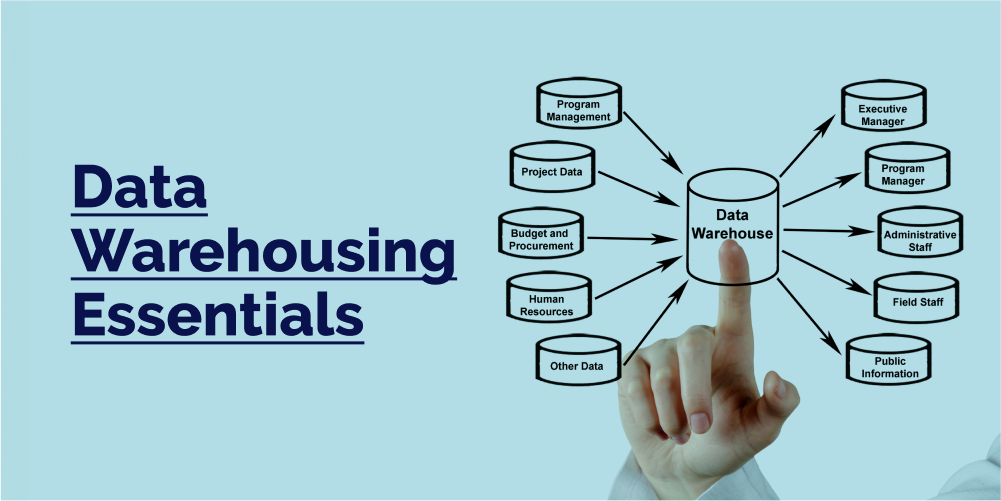Digital Transformation, zBlog
Data Warehousing – Definition, Types, Process, Use Cases, Components
Team Trantor | Updated: March 13, 2025
Introduction
The ability to effectively collect, store, and analyze information has become a critical competitive advantage in today’s data-driven business landscape. Organizations that can harness the power of their data are better equipped to make informed decisions, drive innovation, and stay ahead of the curve. At the heart of this data-driven transformation is the concept of data warehousing.
Data warehousing is the foundation upon which organizations build their data-driven strategies, enabling them to unlock the value of their disparate data sources and transform them into actionable insights. By providing a centralized, integrated, and high-performance data repository, data warehouses empower businesses to make more informed decisions, optimize their operations, and enhance their overall competitiveness.
In this comprehensive article, we’ll explore the world of data warehousing, delving into its definition, the different types of data warehouses, the data warehousing process, common use cases, and the key components that make up a robust data warehousing solution.
What is Data Warehousing?

Data warehousing is the process of collecting, integrating, and storing data from multiple sources into a centralized and structured repository, known as a data warehouse. This data warehouse is designed to support analytical and reporting needs, allowing organizations to make informed business decisions.
Unlike traditional operational databases, which are primarily focused on day-to-day transactional processing, data warehouses are optimized for the storage, management, and analysis of large volumes of historical data. This data can come from a variety of sources, including internal systems, external databases, and even unstructured data sources such as web logs and social media feeds.
The key characteristics of a data warehouse include:
- 1. Subject-Oriented: Data warehouses are designed to support specific business needs or subject areas, such as sales, finance, or customer management, rather than the operational needs of a particular department or function.
- 2. Integrated: Data from various sources is integrated and transformed into a consistent format, ensuring that the data is clean, consistent, and ready for analysis.
- 3. Time-Variant: Data warehouses store historical data, allowing organizations to analyze trends and patterns over time, rather than just the current state of the business.
- 4. Non-Volatile: Data in a data warehouse is not subject to frequent updates or deletions, ensuring that the data remains stable and consistent for analytical purposes.
Types of Data Warehouses

There are several different types of data warehouses, each with its own unique characteristics and use cases. The most common types include:
- 1. Enterprise Data Warehouse (EDW): An EDW is a centralized data warehouse that serves the entire organization, providing a single source of truth for all business data. EDWs are typically large-scale, complex, and designed to support a wide range of analytical and reporting needs.
- 2. Departmental Data Warehouse: A departmental data warehouse is a smaller-scale data warehouse that focuses on the specific needs of a particular department or business unit, such as sales, marketing, or finance.
- 3. Data Mart: A data mart is a subset of a larger data warehouse, typically designed to serve the needs of a specific department or business function. Data marts are often more specialized and targeted than enterprise-wide data warehouses.
- 4. Online Analytical Processing (OLAP) Data Warehouse: OLAP data warehouses are designed to support complex, multi-dimensional analysis and reporting, allowing users to quickly and easily explore data from multiple perspectives.
- 4. Real-Time Data Warehouse: Real-time data warehouses are designed to provide near-instantaneous access to the latest data, enabling organizations to make decisions based on the most up-to-date information.
The Data Warehousing Process

The data warehousing process typically consists of the following key steps:
- 1. Data Extraction: The first step in the data warehousing process is to extract data from various source systems, such as operational databases, ERP systems, and external data sources.
- 2. Data Transformation: Once the data has been extracted, it must be transformed into a consistent format that can be easily integrated into the data warehouse. This may involve cleaning, standardizing, and enriching the data.
- 3. Data Loading: The transformed data is then loaded into the data warehouse, where it is stored in a structured and organized manner, typically using a star schema or snowflake schema design.
- 4. Data Modeling: The data in the data warehouse is modeled to support the specific analytical and reporting needs of the organization. This may involve creating fact tables, dimension tables, and other data structures.
- 5. Data Maintenance: Ongoing maintenance of the data warehouse is essential to ensure that the data remains accurate, up-to-date, and aligned with the organization’s evolving needs. This may include tasks such as data backup, disaster recovery, and data archiving.
- 6. Data Access and Analysis: Finally, users can access the data warehouse to perform a wide range of analytical and reporting tasks, from ad-hoc queries to complex, multi-dimensional analyses.
Use Cases for Data Warehousing
Data warehousing has a wide range of applications across various industries and business functions. Some of the most common use cases include:
- 1. Business Intelligence and Reporting: Data warehouses provide a centralized repository of data that can be used to generate reports, dashboards, and other business intelligence tools, enabling organizations to make more informed decisions.
- 2. Sales and Marketing Analytics: Data warehouses can be used to analyze sales data, customer behavior, and digital marketing campaigns, helping organizations identify trends, optimize their marketing strategies, and improve customer engagement.
- 3. Financial Analysis: Data warehouses can be used to track financial data, such as revenue, expenses, and profitability, allowing organizations to identify areas for cost savings, improve financial planning, and ensure compliance with regulatory requirements.
- 4. Supply Chain Optimization: Data warehouses can be used to analyze supply chain data, such as inventory levels, supplier performance, and logistics, enabling organizations to optimize their supply chain operations and improve efficiency.
- 5. Fraud Detection and Risk Management: Data warehouses can be used to identify patterns and anomalies in data, enabling organizations to detect and prevent fraud, as well as manage various types of business risk.
- 6. Healthcare Analytics: In the healthcare industry, data warehouses are used to aggregate and analyze patient data, helping healthcare providers improve patient outcomes, optimize care delivery, and comply with regulatory requirements.
Key Components of a Data Warehousing Solution

A comprehensive data warehousing solution typically includes the following key components:
- 1. Data Sources: The various internal and external data sources that feed into the data warehouse, such as operational databases, CRM systems, and web analytics.
- 2. Extract, Transform, and Load (ETL) Tools: The tools and processes used to extract data from the source systems, transform it into a consistent format, and load it into the data warehouse.
- 3. Data Warehouse Database: The underlying database technology that stores and manages the data in the data warehouse, such as a relational database management system (RDBMS) or a NoSQL database.
- 4. Data Modeling and Design: The data models and design principles that are used to organize and structure the data in the data warehouse, such as the star schema or snowflake schema.
- 5. Data Warehouse Management Tools: The tools and processes used to manage the data warehouse, including data backup and recovery, performance tuning, and data lifecycle management.
- 6. Business Intelligence (BI) and Analytics Tools: The tools and applications that enable users to access, analyze, and visualize the data stored in the data warehouse, such as dashboards, reports, and advanced analytics.
- 7. Data Governance and Security: The policies, processes, and technologies used to ensure the quality, reliability, and security of the data stored in the data warehouse, including data access controls, data lineage, and data quality management.
Frequently Asked Questions (FAQs) About Data Warehousing and ETL
What do you mean by a data warehouse?
A data warehouse is a centralized repository designed to store large volumes of structured and unstructured data from multiple sources. It enables businesses to perform data analysis, generate reports, and make informed decisions. In the context of digital transformation solutions, data warehouses play a crucial role in ensuring seamless enterprise application integration.
What are the four components of a data warehouse?
The four key components of a data warehouse are:
- Data Source Layer – Collects data from multiple sources such as CRM, ERP, and web applications.
- Data Integration Layer – Utilizes ETL (Extract, Transform, Load) processes to clean, transform, and consolidate data.
- Data Storage Layer – Centralized storage that organizes data for efficient querying and reporting.
- Data Presentation Layer – Tools like BI dashboards and visualization platforms that present insights to users.
What is a data warehouse in ETL?
In ETL processes, a data warehouse is the final destination where extracted data is cleaned, transformed, and loaded for analysis. ETL tools ensure data accuracy, consistency, and readiness for reporting. This process is essential for businesses like Trantor, ensuring streamlined data flow for robust enterprise application integration.
What are the three types of data warehouses?
The three primary types of data warehouses are:
- Enterprise Data Warehouse (EDW): Centralized storage for comprehensive business data, ideal for large organizations.
- Operational Data Store (ODS): Real-time data repository designed for daily operations and quick updates.
- Data Mart: A subset of a data warehouse focused on specific business units like sales, marketing, or finance.
Advanced Concepts in Data Warehousing
In addition to understanding the fundamental concepts of data warehousing, diving deeper into advanced strategies, techniques, and technologies can provide businesses with enhanced capabilities to manage and analyze data effectively. In this extended guide, we’ll explore additional insights on data warehousing, including architectural patterns, implementation strategies, and emerging trends that are shaping the future of data warehousing.
Advanced Data Warehouse Architectures
A well-structured data warehouse architecture is essential for optimizing performance, ensuring scalability, and enhancing data integration. Here are some advanced architectural models:
- Hub-and-Spoke Architecture: This model involves a centralized data warehouse (the hub) that integrates data from multiple sources. Individual data marts (the spokes) are created for specific business functions.
- Federated Data Warehouse: This architecture integrates data from distributed and heterogeneous sources without physically moving the data. It leverages virtualized data views for seamless data access.
- Data Vault Architecture: Data vault modeling is designed to handle rapidly changing data requirements by separating business keys, descriptive data, and historical data. It ensures flexibility and scalability.
- Cloud-Based Data Warehousing: Cloud platforms such as Amazon Redshift, Google BigQuery, and Snowflake offer scalable, cost-effective solutions for data warehousing, simplifying infrastructure management.
- Hybrid Data Warehouse: This model combines on-premises infrastructure with cloud data storage, ensuring businesses can leverage existing systems while scaling with cloud resources.
Key Technologies in Modern Data Warehousing
To build a robust and efficient data warehouse, leveraging cutting-edge technologies is essential:
- In-Memory Computing: By storing data in RAM rather than traditional disk storage, in-memory computing enables faster data retrieval and real-time analytics.
- Columnar Storage: Unlike traditional row-based storage, columnar databases enhance analytical query performance by grouping data by column, improving compression and reducing I/O overhead.
- Data Lake Integration: Modern data warehouses are often integrated with data lakes, combining structured and unstructured data for comprehensive analytics.
- Data Virtualization: This technique allows users to query and analyze data from multiple systems without physically moving the data.
- AI and Machine Learning Integration: Embedding advanced AI/ML models into data warehouses allows for predictive analytics, anomaly detection, and pattern recognition.
Enhanced Data Warehouse Process

To achieve optimal performance and data integrity, businesses can follow these enhanced data warehouse process strategies:
- Incremental Data Loading: Instead of loading entire datasets, incremental loading updates only the changed or new data, improving efficiency.
- Real-Time Data Streaming: Tools like Apache Kafka and Amazon Kinesis enable real-time data ingestion for instant insights.
- Automated Data Quality Checks: Integrating automated tools for data profiling, cleansing, and validation ensures consistent data quality.
- Metadata Management: Maintaining comprehensive metadata enhances data lineage tracking, impact analysis, and governance.
- Data Security Best Practices: Implementing encryption, role-based access control (RBAC), and auditing mechanisms ensures data security and compliance.
Emerging Trends in Data Warehousing
The data warehousing landscape is continuously evolving with several emerging trends:
- Data Mesh Architecture: This decentralized model emphasizes treating data as a product, with cross-functional teams managing their respective data domains.
- Serverless Data Warehousing: Platforms like Amazon Redshift Spectrum and Google BigQuery enable serverless data processing, reducing infrastructure overhead.
- Augmented Analytics: Combining data warehousing with AI-driven insights and NLP capabilities allows for more intuitive data exploration.
- Graph Databases for Enhanced Relationships: Graph databases like Neo4j enable deeper insights into complex relationships within data.
- DataOps for Agile Data Management: DataOps practices streamline data management through CI/CD pipelines, improving collaboration and automation.
Real-World Use Cases for Data Warehousing
Industries worldwide are adopting data warehousing to unlock powerful insights and drive data-driven decisions:
- Retail and E-commerce: Data warehouses help analyze customer behavior, track sales performance, and manage inventory in real-time.
- Banking and Finance: Financial institutions leverage data warehouses for fraud detection, risk assessment, and regulatory reporting.
- Healthcare: Data warehousing solutions help healthcare providers improve clinical decision-making, manage patient records, and streamline operations.
- Telecommunications: Telecom companies utilize data warehouses for network performance optimization, customer churn prediction, and service quality analysis.
- Education: Academic institutions use data warehousing to track student performance, improve curriculum planning, and enhance administrative processes.
Best Practices for Successful Data Warehouse Implementation
To ensure your data warehouse solution delivers maximum value, consider these best practices:
- Clearly Define Objectives: Identify specific business goals and align your data warehouse strategy accordingly.
- Engage Key Stakeholders: Collaborate with business users, data engineers, and IT teams throughout the project lifecycle.
- Adopt a Phased Implementation Approach: Start with a pilot project before scaling your data warehouse to the entire organization.
- Ensure Data Governance: Establish clear policies for data ownership, access control, and data quality management.
- Invest in User Training: Empower end-users with training on data analysis tools to maximize value from your data warehouse.
The Future of Data Warehousing
As the business landscape continues to evolve and the volume, velocity, and variety of data continue to grow, the role of data warehousing in driving organizational success will only become more critical. By providing a centralized, integrated, and high-performance data repository, data warehouses empower organizations to make more informed decisions, optimize their operations, and stay ahead of the competition.
Looking to the future, we can expect to see several key trends emerge in the world of data warehousing, including:
- 1. Increased adoption of cloud-based data warehousing solutions, which offer greater scalability, flexibility, and cost-effectiveness.
- 2. The integration of advanced analytics and machine learning capabilities into data warehousing solutions, enables organizations to uncover deeper insights and drive more informed decision-making.
- 3. The emergence of real-time and near-real-time data warehousing solutions, provides organizations with the ability to make decisions based on the latest data.
- 4. Greater emphasis on data governance and security, as organizations seek to ensure the quality, reliability, and security of their data assets.
- 5. The integration of data warehousing with other data-driven technologies, such as the Internet of Things (IoT) and big data, to create more comprehensive and powerful data ecosystems.
As organizations continue to navigate the challenges and opportunities of the digital age, the importance of data warehousing will only continue to grow. By leveraging the power of data warehousing, businesses can unlock the full potential of their data, drive innovation, and stay ahead of the competition. Trantor has helped organizations across various industries unlock the power of their data and make more informed decisions. With our deep expertise in data architecture, ETL processes, and advanced analytics, we have the capabilities to design and implement robust data warehousing solutions that align with our clients’ strategic objectives.
Whether you’re looking to build a centralized enterprise data warehouse, streamline your departmental data marts, or implement real-time analytics capabilities, Trantor has the experience and the tools to help you succeed. By leveraging our data warehousing expertise, our clients have been able to improve operational efficiency, enhance customer experiences, and gain a competitive edge in their respective markets.
Conclusion
By understanding the data warehouse process, exploring different types of data warehouse architectures, and adopting best practices, businesses can unlock the full potential of their data. A robust data warehousing solution powered by modern technologies can drive informed decision-making, improve operational efficiency, and enhance customer experiences.
Trantor has extensive expertise in building customized data warehousing solutions that align with your business objectives. Our comprehensive approach covers everything from defining the data warehousing definition to implementing essential components of data warehouse systems. Whether you’re exploring data warehouse components for your enterprise or optimizing your data warehouse process, Trantor is your trusted partner in delivering reliable data warehousing components that support your growth strategy.






